Bilateral Head&Neck 70/63/56Gy (2013 Pinnacle/ROR Plan Challenge
VMAT SX1
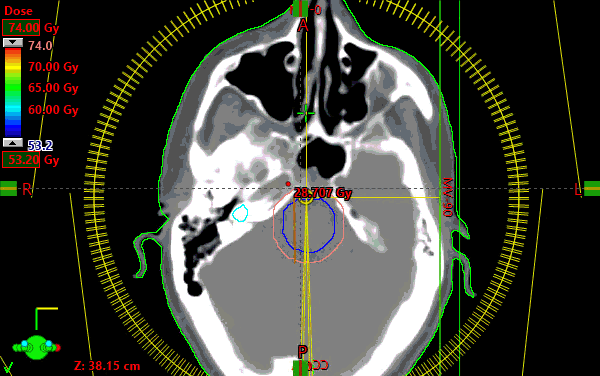 |
Rx: 70Gy/35fx to PTV70, also PTV63 and PTV56 (simultaneous integrated boost)
2013 Pinnacle ROR Plan Challenge

2:50 VMAT treatment arc delivery time
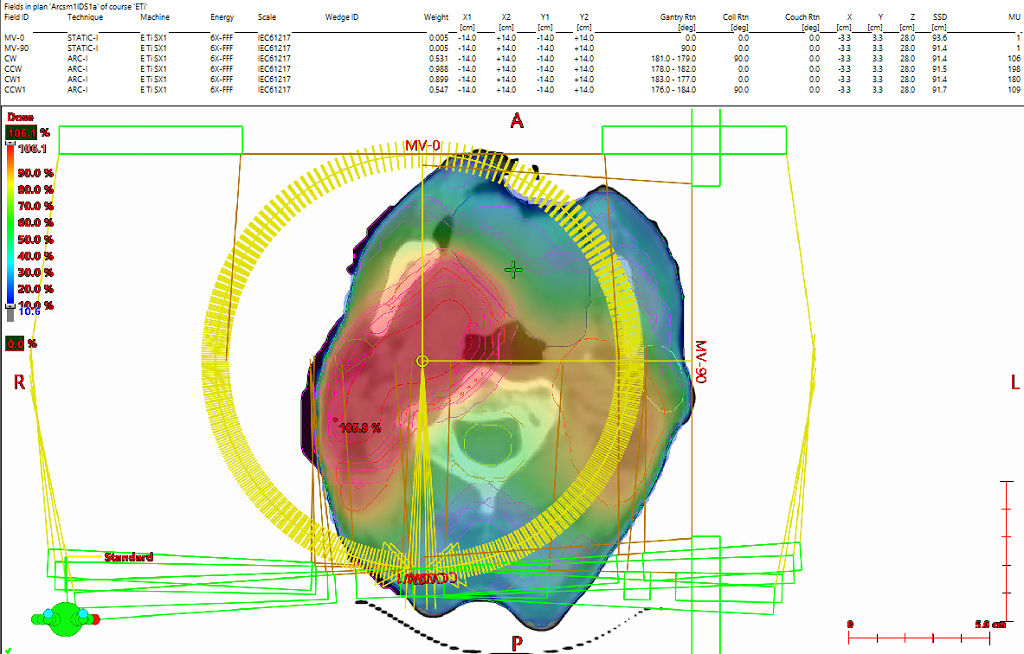 |
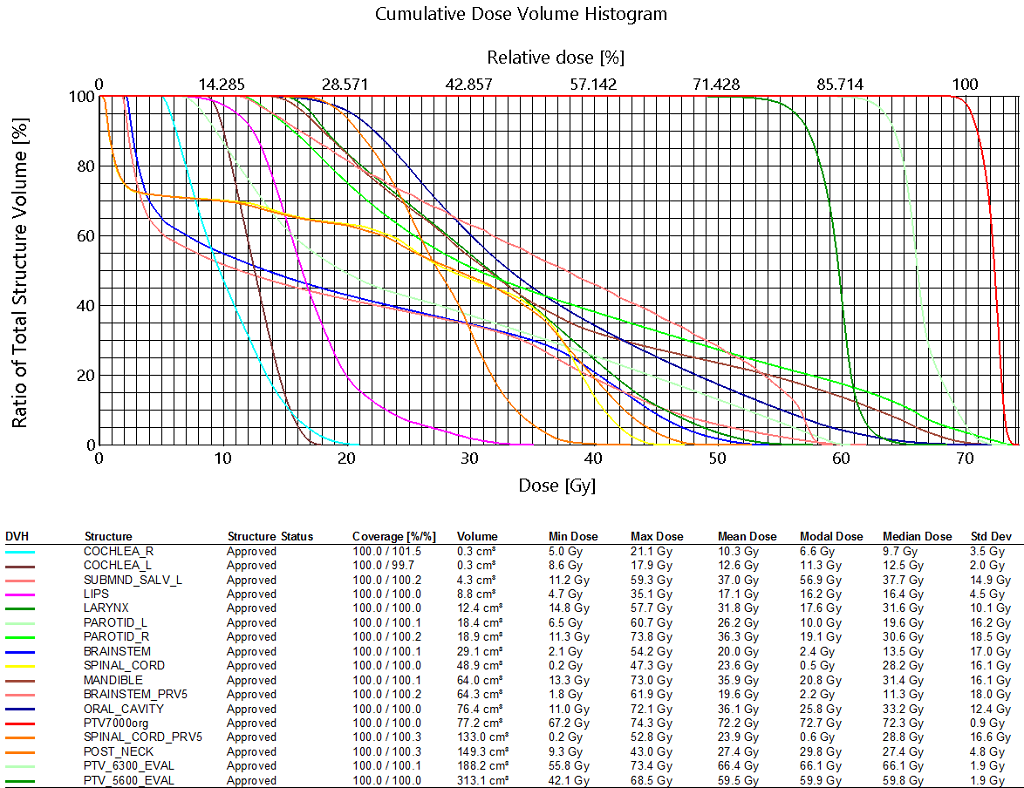 |
Plan or PlanSum ID: Arcsm1IDS1a
| Structure ID | Structure Code | Patient Structure | DVH Objective | Evaluator | Variation | Priority | Met | Achieved |
| PTV7000org | PTV7000org | V70.0Gy[%] | >=95 | 90 | Goal | 97.87 % | ||
| PTV7000org | PTV7000org | V66.5Gy[%] | >=99 | 97 | Goal | 100.00 % | ||
| PTV7000org | PTV7000org | D0.03cc[Gy] | <=72.8 | 77 | Variation | 74.006 Gy | ||
| PTV_6300_EVAL | PTV_6300_EVAL | V63.0Gy[%] | >=95 | 90 | Goal | 96.80 % | ||
| PTV_6300_EVAL | PTV_6300_EVAL | V59.85Gy[%] | >=99 | 97 | Goal | 99.87 % | ||
| PTV_5600_EVAL | PTV_5600_EVAL | V56.0Gy[%] | >=95 | 90 | Goal | 95.81 % | ||
| PTV_5600_EVAL | PTV_5600_EVAL | V53.2Gy[%] | >=99 | 97 | Goal | 99.30 % | ||
| SPINAL_CORD | SPINAL_CORD | D0.03cc[Gy] | <48 | Goal | 45.647 Gy | |||
| SPINAL_CORD_PRV5 | SPINAL_CORD_PRV5 | D1.0cc[Gy] | <=50 | 54 | Goal | 47.055 Gy | ||
| BRAINSTEM | BRAINSTEM | D0.03cc[Gy] | <54 | Goal | 52.888 Gy | |||
| BRAINSTEM_PRV5 | BRAINSTEM_PRV5 | D1.0cc[Gy] | <=57 | 60 | Goal | 56.356 Gy | ||
| PAROTID_L | PAROTID_L | Mean[Gy] | <=26 | 40 | Variation | 26.236 Gy | ||
| PAROTID_R | PAROTID_R | V30.0Gy[%] | <=50 | 65 | Variation | 50.95 % | ||
| LARYNX | LARYNX | Mean[Gy] | <=40 | 55 | Goal | 31.826 Gy | ||
| SUBMND_SALV_L | SUBMND_SALV_L | Mean[Gy] | <=35 | 65 | Variation | 37.031 Gy | ||
| COCHLEA_L | COCHLEA_L | D0.03cc[Gy] | <=15 | 40 | Variation | 15.396 Gy | ||
| COCHLEA_R | COCHLEA_R | D0.03cc[Gy] | <=15 | 40 | Variation | 15.224 Gy | ||
| MANDIBLE | MANDIBLE | V70.0Gy[%] | <=0 | 5 | Variation | 0.63 % | ||
| LIPS | LIPS | V30.0Gy[%] | <=0 | 30 | Variation | 1.79 % | ||
| POST_NECK | POST_NECK | V35.0Gy[%] | <=10 | 40 | Goal | 5.86 % |
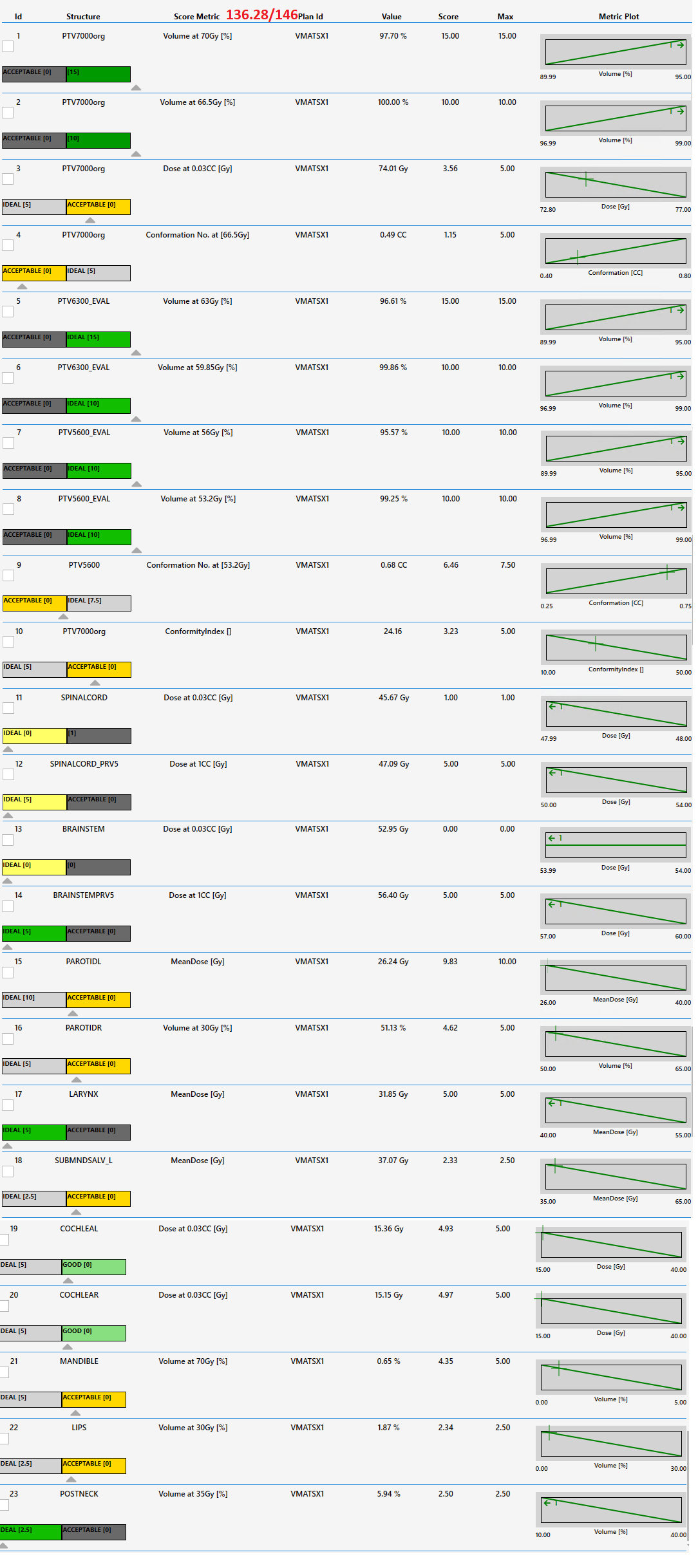 |
Four (4) arc VMAT technique was chosen and (4) four almost complete arcs were used. Each arc used a different start and stop angles offset by 1 degree in order to stagger the available control points throughout each arc rotation. VMAT is an excellent treatment technique for regular (spherical) shaped targets when the isocenter can be placed inside the target volume, however, for highly irregular shaped targets like the lowest dose level target in this head and neck plan, a VMAT technique proved to be unable to match the plan quality achieved in the static gantry plan (#4 Bilateral Head & Neck (IMRT). With a treatment delivery time within 60 seconds of the comparable IMRT plan and more optimization time required for VMAT planning, the IMRT plan could be considered preferable to in this case. This plan might have been improved by utilizing unique collimator rotations in each arc. This VMAT plan scored better than 80%-90% of the plans submitted to the plan challenge.
There is very little difference between this VMAT plan versus for the 9F IMRT plan for the same case. Homogeneity and conformity are respected. OARs are well within constraint goals. Both plans do an excellent job at sparing the contralateral parotid, with mean doses around 25 Gy. This is clearly an acceptable plan.
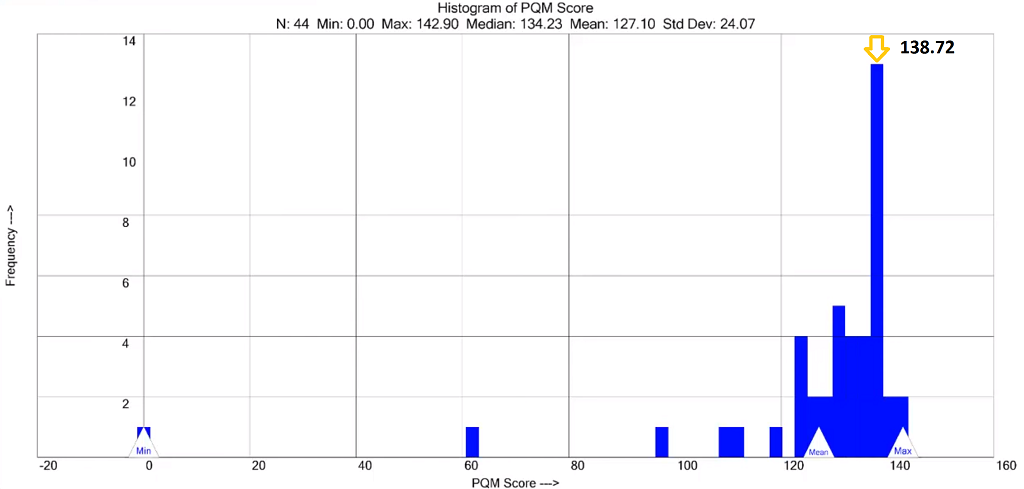 |
|
3rd party software plan report |
Dosimetric ScoreCard |
DICOM patient export |
Any reference to a "plan study" are simply what the organizers call each case and may not be a "study" in the FDA sense as they may not have been published in a peer reviewed journal.
Varian does not provide medical advice and these are illustrative examples only.
Leading plans by expert planner. Your results may vary.
FOR EDUCATIONAL AND SCIENTIFIC EXCHANGE ONLY – NOT FOR SALES OR PROMOTIONAL USE.